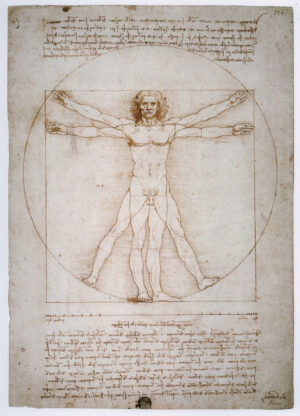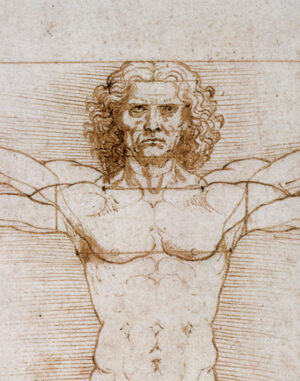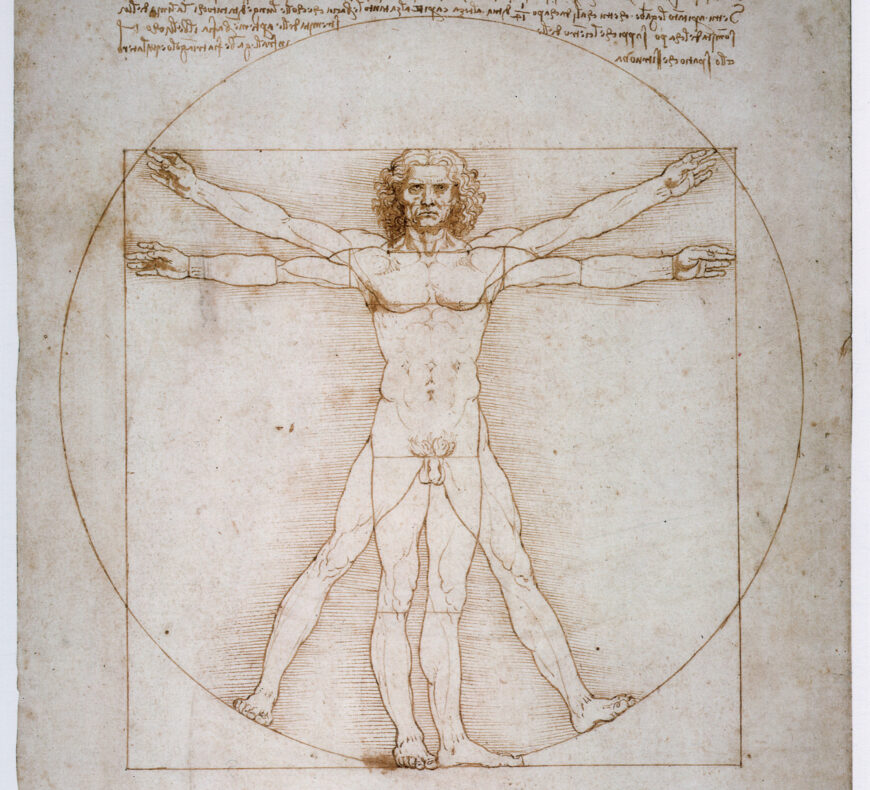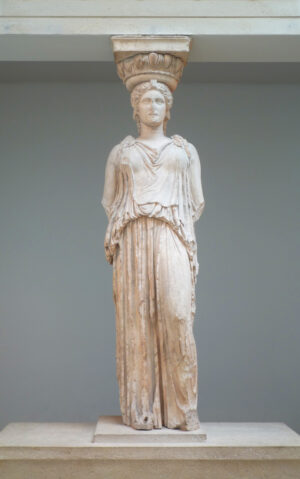
Leonardo da Vinci, “Vitruvian Man,” c. 1490, pen and watercolor over metalpoint on paper, 34.4 x 24.5 cm (Gallerie dell’Accademia, Venice)
A modest drawing
Leonardo da Vinci’s so-called “Vitruvian Man” drawing has been reproduced, spoofed, and made into memes so often that the image has come to signify far more than it did in the 15th century when it was made. In fact, the “Vitruvian Man” has come to signify broad, general ideas such as “culture,” “genius,” “humanism,” or more specifically “Western civilization”—ideas far beyond its modest origins as a private notebook illustration.
The drawing, which visualizes an idea of human proportions from an ancient Roman architectural text by Vitruvius, measures slightly smaller than a sheet of printer paper at 343 x 245 mm (approximately 13 1/2 x 9 3/4 inches). Yet the “Vitruvian Man” creates a large visual impact through its clear and restrained composition. Three elements form the image: a single male figure, one circle, and one square. The man stands facing frontally while his hands and feet rest on the edges of both the circle and square. Vitruvius wrote in Book 3 of De architectura that a circle and a square could be drawn centered from the navel of an outstretched human figure. To achieve this, Leonardo doubled the man’s limbs. One set of arms reaches the circle, the other the square.

Three-dimensional modeling (detail), Leonardo da Vinci, “Vitruvian Man,” c. 1490, pen and watercolor over metalpoint on paper, 34.4 x 24.5 cm (Gallerie dell’Accademia, Venice)
The drawing’s sparseness contributes to its diagrammatic quality. The square and circle exist solely as two-dimensional shapes drawn with a single thin line, but Leonardo fleshed out the head of his human figure with shading to imply three-dimensionality. Cheek crags and deep eye sockets give the figure’s head a three-dimensionality at odds with the outlined body. Clarity is privileged over aesthetics as with a scientific illustration in an anatomical text. The square and circle are clear and precisely traced. The abstraction of the human body into a technical drawing, the absence of color, or any description of a spatial setting also indicate the viewer should read this image as informational.
Leonardo’s effort to visualize Vitruvius’ written description of ideal proportions can be understood as part of a general cultural interest in the idea of “perfect” proportions that Italian Renaissance culture had absorbed from classical thought. Undergirding Vitruvius’ discussion of architecture is the idea that perfect proportions exist and that there is a singular correct—and desirable—set of measurements for buildings. While contemporary viewpoints tend to state there is no one right way of making good art, that was not always the case. Italian Renaissance art theory, following classical examples, often took the perspective that good art could be dictated by a set of principles—and proportions.
Therefore, we should be hesitant to read the “Vitruvian Man” as an artwork per se, or an image meant to be appreciated aesthetically even though the meticulous lines tell us the drawing is not a study (in which we might see a foot or hand repeated multiple times as the artist worked through the exact parameters). Instead, it is clear the drawing was not a hastily dashed-off sketch, but rather a thoughtfully considered, planned endeavor.
The “Vitruvian Man’s” audience
European artists rarely made drawings that were intended to be finished independent artworks prior to the 16th century. Drawings more often served utilitarian functions. Artists working in the Italian peninsula area would submit compositional drawings for approval from patrons before using costly materials. Drawings were also made for workshop use. Studio assistants and apprentices in artistic workshops used study drawings as guides for creating drapery, gestures, anatomy, and even animals. Workshops also prepared full-scale transfer drawings for large projects instead of drawing compositional outlines freehand. These utilitarian drawings assumed a small audience and were not intended to circulate beyond workshop assistants and clients.

Central figure and shapes (detail), Leonardo da Vinci, “Vitruvian Man,” c. 1490, pen and watercolor over metalpoint on paper, 34.4 x 24.5 cm (Gallerie dell’Accademia, Venice)
We cannot know if Leonardo intended anyone besides himself to see the “Vitruvian Man” drawing, but in the left corner of the page the artist wrote, “Messer Ottaviano Pallavicino pel suo Vetruvius” (Mr. Ottaviano Pallavicino for his [copy of] Vitruvius), indicating that he had borrowed the book from Pallavicino. Occasionally this note has been interpreted to mean the drawing was intended as a gift for Pallavicino. However, the left-handed Leonardo wrote the text surrounding the image in his customary mirrored handwriting that would have been illegible to most people beside himself.
Like other artists, Leonardo made preparatory drawings and studies for commissioned artworks. Although it was common for artists to keep notebooks for their own consultation, the volume of Leonardo’s notes are exceptional. In his notebooks, Leonardo drew and wrote to explore his own curiosity. The artist kept notebooks throughout his life for sketches, observations, research, and personal study.
The two sections of text framing the drawing are copied from Vitruvius’s De architectura. Reading Vitruvius’ De architectura as well as Plato’s Timaeus acquainted Leonardo with the common classical idea that architectural and human proportions could be analogous. In Book 3 of De architectura, Vitruvius compared the symmetry and harmony of a temple’s architecture to the human body. As a beautiful building is made up of parts relating to each other in a system of predictable mathematical ratios, so too, Vitruvius theorized, could the human body be understood as proportional parts.

Caryatid, South Porch of the Erechtheion, Acropolis, Athens, marble, 421–407 B.C.E. (Classical Period) (© The Trustees of the British Museum, London; photo: Steven Zucker, CC BY-NC-SA 2.0)
Architecture and the ideal body
Contemporary readers might be surprised that a discussion of human figural proportion was included in a book on architecture, but Vitruvius was writing during the 1st century B.C.E. and in the Greco-Roman cultural tradition which had long compared human figures to architecture. In the classical world, architecture meant more than merely the practical construction of buildings. Greco-Roman thought intertwined architecture with other arts, natural history as well as engineering. Sometimes columns were not only metaphorically understood as human figures, but were shaped as human figures as in the case of the 5th-century B.C.E. Caryatid Porch at the Acropolis in Athens.
While many art writers recommended artists study nature, they also advised that artists should improve upon nature. Repeating classical advice, Italian Renaissance theorists often recommended artists select beautiful parts—a leg from one person, a nose from another—and combine those disparate parts into an ideal body. While drawn from nature, the ideal figure was understood to be artificial, impossible to find in nature. Therein lies the contradiction of Leonardo’s “Vitruvian Man”: to create the conditions Vitruvius says can be found “in nature,” Leonardo had to resort to an unnatural doubling of limbs. Therefore, ideal human proportions parallel architectural proportions for buildings: both are mathematical abstractions.
Italian Renaissance artistic pursuit of the ideal, the perfect, straddled a desire to imitate nature and the acknowledgment that ideals did not exist in nature. The “Vitruvian Man” drawing, an effort to realize a classical idea that the ancient world had only proposed, speaks to the greater cultural project of improving upon classical ideals. Much like Michelangelo’s statue of David sought to surpass ancient classical nudes and Renaissance central plan churches aimed to realize a mathematical expression of God’s perfection, the “Vitruvian Man” presupposes, with enough effort, idealism can be achieved in human reality.

